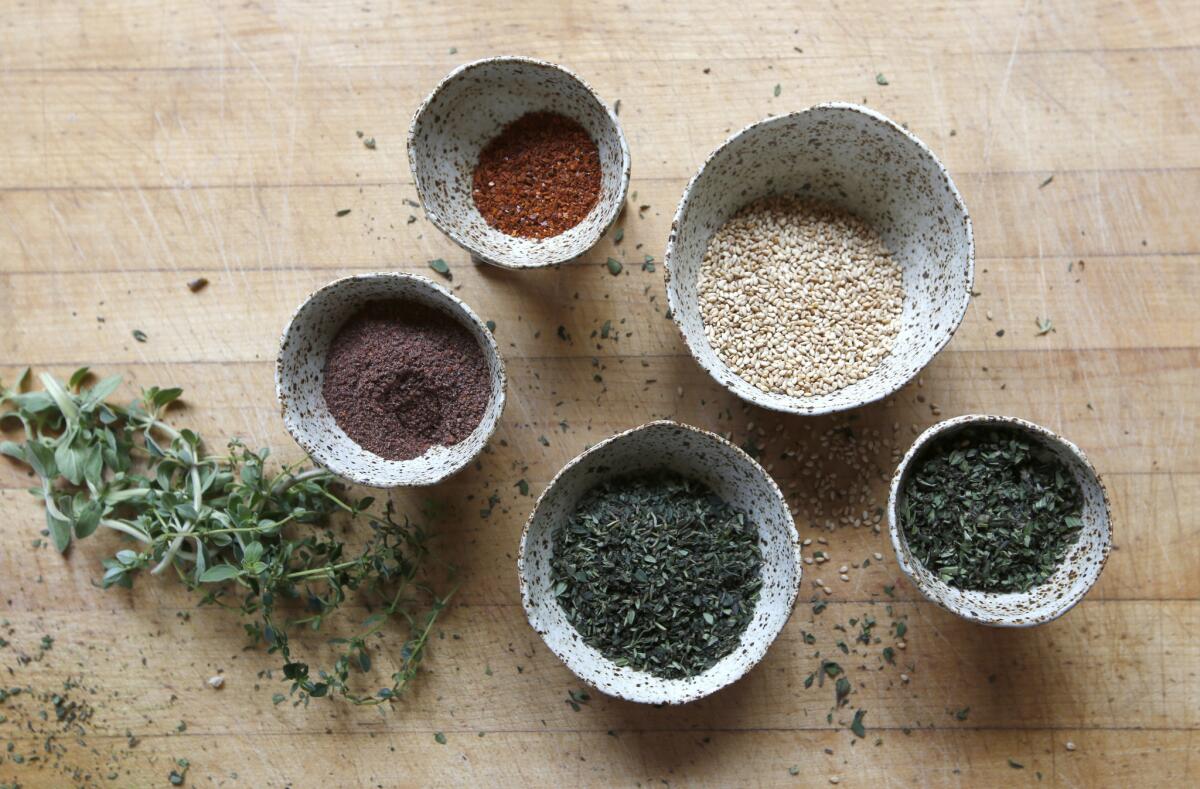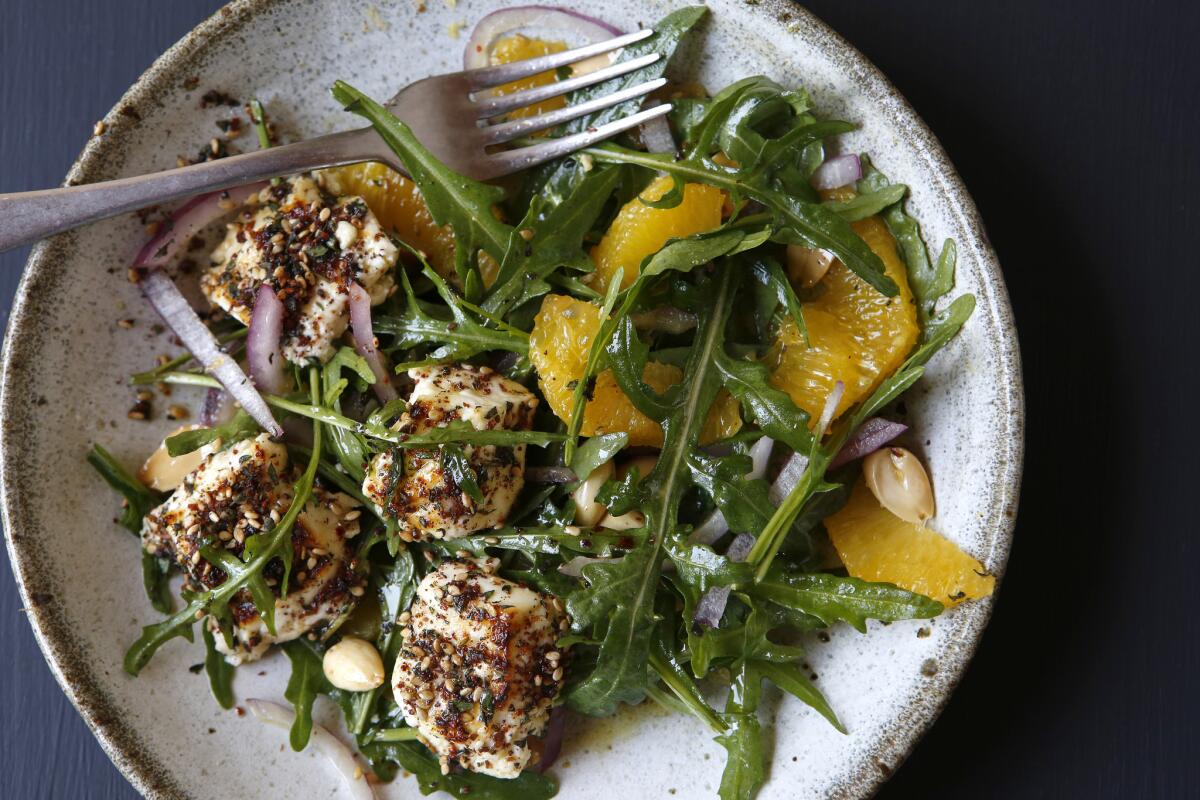Love za’atar? Try making the addictive Middle Eastern spice blend at home
- Share via
With a name that sounds like an exotic superhero, za’atar can save food from blandness with just a sprinkle. The woodsy, herbal, citrusy spice blend from the Middle East is thrilling to eat — one taste and the palate veers in surprising and delicious directions.
Za’atar is a harmony of herb, sesame seed and sumac. The herb component can be thyme, oregano, marjoram or a combination of the three; recipes vary throughout the Middle East depending on region and availability. Za’atar, translated from Arabic, refers to this collection of herbs, Origanum, but it has also come to mean the spice blend, similarly to how chili powder here is both the powdered chili and a mix of dried chiles, cumin and oregano. Sumac, if you’re not familiar with it, is the ground berry from the Sicilian sumac plant, Rhus coriaria. It has a deep red color and delightfully tart and tannic taste.

Chef and celebrated cookbook author Yotam Ottolenghi has contributed to za’atar becoming popular with well-heeled cookbook collectors, but the spice blend has been a staple in the Middle East for centuries. Manaesh, a flatbread with a thick topping of za’atar, is as ubiquitous for breakfast as doughnuts are here. I got my first taste of za’atar as a child growing up in Pasadena in the ‘70s. Back then, knowledgeable cooks would shop at the small Armenian grocers on Pasadena’s Washington Boulevard for good feta, olives, sarma (Armenian stuffed grape leaves), what we called Armenian pizzas — lamajoun, a very thin ground-lamb-topped flatbread — and that prized manaesh to serve at cocktail parties. Reheated, the unfamiliar and exotic za’atar atop the manaesh would become warm and fragrant — and I got hooked by that alluring flavor.Commercial za’atar blends are available at Middle Eastern markets where they can look like big bags of powdered moss. I’ve even seen them at big box multicultural supermarkets with their own display — and a sign declaring “It’s party thyme.” While these purchased blends are good, the flavor can be a bit harsh and the contents pretty, well, dry.
When you make your own za’atar with fresh herbs from the garden or farmers market, the flavor is more subtle and nuanced than the powdery stuff in stores but equally compelling — and with that brightness that only fresh herbs can lend. The aromatic qualities of fresh, floral thyme and mildly piney oregano are rounded out in a most delicious way by nutty toasted sesame seeds and lemony sumac. And because a snap of heat is always a good thing, a dash of Aleppo pepper is added.

Recipe: Cracked wheat mana’esh (flatbread with za’atar)
The most popular use of za’atar is on the aforementioned manaesh or manakish, a flatbread-like pizza with a slick of the pungent green herb blend. Here is a California version of the Middle Eastern staple featuring whole-grain flour, cracked wheat, good olive oil and the fresh herb za’atar. Hot off the griddle or grill with a spoonful of labneh (kefir cheese), and you’re pretty much transported. This version, topped with a fried egg and a small handful of parsley, is Sunday brunch worthy.
Za’atar is also really good with feta, and when the feta is broiled, drizzled with honey, then sprinkled with za’atar, it’s amazing. Pair the salty-sweet za’atar-coated cheese with peppery arugula for balance, add succulent oranges to highlight the lemony sumac, biting onions to play off the funk of the herbs, and almonds for a good crunch.
Once you’ve sampled this fresh and heady spice blend on the flatbread and salad, you too will be convinced of za’atar’s superpowers. This updated spice can indeed transform ordinary into sublime.

Recipe: Wild arugula augula and orange salad with baked feta, honey and za’atar
::
10 ways of cooking with fresh homemade za’atar:
1. Mix za’atar with good olive oil and use it as a dip for warm pita or country bread.
2. Sauté canned chickpeas with a little olive oil and garlic, sprinkle with za’atar and serve with plain yogurt for lunch or a light dinner.
3. Make a Lebanese caprese salad: Scatter spoonfuls of labneh over sliced tomatoes, drizzle with olive oil and sprinkle with za’atar.
4. Roast a chicken with za’atar using your favorite roast lemon chicken recipe and sprinkle the bird generously with za’atar before and after roasting.
5. Change up your avocado toast with a sprinkle of za’atar.
6. Sprinkle za’atar over fish before and after grilling and serve with fresh lemon wedges.
7. Sprinkle za’atar liberally over roasted vegetables such as cauliflower, carrots and potatoes.
8. Top fried eggs with crumbled feta, chopped parsley, dashes of hot pepper sauce and a sprinkle of za’atar for breakfast or brunch.
9. Add zip to hummus dip with a douse of olive oil and dash of za’atar.
10. Grill zucchini and eggplant slices and sprinkle with a light layer of za’atar.
More to Read
Eat your way across L.A.
Get our weekly Tasting Notes newsletter for reviews, news and more.
You may occasionally receive promotional content from the Los Angeles Times.









